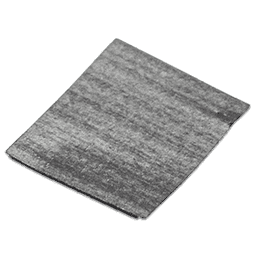Thermal Grizzly KryoSheet Review – Tested on RX 7900 XTX with 475 W
Source: Tech Power Up added 14th Jan 2024Introduction
Thermal Grizzly’s KryoSheet is a super-thin graphene thermal pad that’s designed to be an alternative to traditional thermal paste. Instead of a paste, you get a sheet that’s just 0.2 mm thin, which reminds me more of the look and feel of a piece of fabric. This makes it much easier to apply, because you literally just drop it onto the surface you want to cool. Priced at $20-$25 for various dimensions, the pad is not cheap, but it promises excellent thermal conductivity and ease of use.
According to the manufacturer, the pad is made from Graphene, which is a single layer of carbon atoms arranged in a special pattern. It’s really good at conducting heat because of its unique structure, which is why it’s often mentioned as selling point for various cooling applications. In my personal experience these “graphene” products are often just “graphite”—a different form of carbon, or they contain only miniscule amounts of graphene in very small flakes.
On their website Thermal Grizzly explains “have a molecular structure stacked in the Z-direction. This optimized structure enables outstanding and constant thermal conductivity. This is due to a specially developed manufacturing process in which the hexagonal crystal structure of the graphite is broken up along the basal plane in order to exploit the anisotropy of the graphite’s thermal conductivity. However, as a side effect of this complex manufacturing process, the electrical conductivity is also increased.”
While that confirms that the material used is not the textbook Graphene that you think of (“a large hexagonal plane of carbon atoms”), it doesn’t really matter. What matters more is how well it cools, if it’s easy to apply, etc, which is exactly what I’ll be looking at in this review.
For testing I’ve picked the ASRock Radeon RX 7900 XTX, which is the most high-powered RX 7900 XTX graphics card available on the market. At maximum power limit I’ve measured it to reach a power draw of over 475 W. The Navi 31 GPU is built using a chiplet approach—a central die is surrounded by six MCD tiles. This makes the whole thing a little bit more uneven—an interesting challenge for the KryoSheet.
media: Tech Power Up
Related posts
Notice: Undefined variable: all_related in /var/www/vhosts/rondea.com/httpdocs/wp-content/themes/rondea-2-0/single-article.php on line 88
Notice: Undefined variable: all_related in /var/www/vhosts/rondea.com/httpdocs/wp-content/themes/rondea-2-0/single-article.php on line 88
Related Products
Notice: Undefined variable: all_related in /var/www/vhosts/rondea.com/httpdocs/wp-content/themes/rondea-2-0/single-article.php on line 91
Warning: Invalid argument supplied for foreach() in /var/www/vhosts/rondea.com/httpdocs/wp-content/themes/rondea-2-0/single-article.php on line 91
